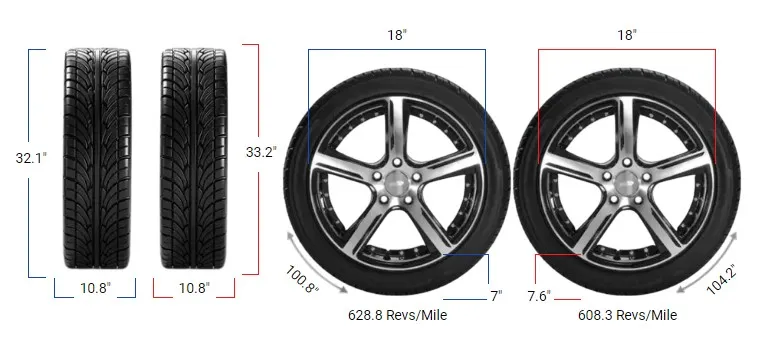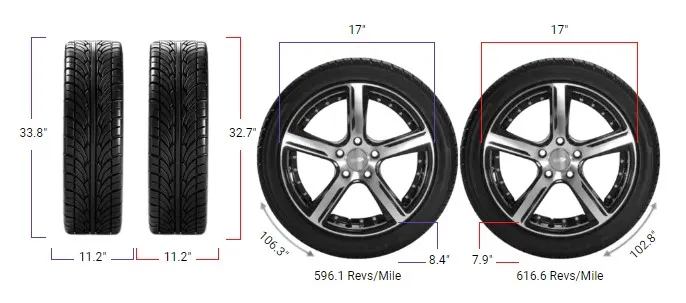Tire Size 30×9.50r15 vs 235/75r15

Tire sizes can seem like a jumble of numbers, but they hold crucial information for your vehicle’s performance. Let’s unravel the mystery behind switching from 30×9.50r15 to 235/75r15 tires and what it means for your ride.
- Diameter decreases by 1.11 inches leading to lower ground clearance
- Width reduces by 0.24 inches potentially affecting traction
- Circumference shrinks by 3.5 inches impacting speedometer accuracy
- Sidewall height drops by 0.56 inches possibly reducing ride comfort
- Revolutions per mile increase by 25.93 affecting fuel economy
- Smaller size may improve handling on paved roads
- Narrower width could enhance performance in mud and snow

Fitment Guide
It’s crucial to stay within the 3% diameter range for safe fitment. The 3.7% decrease from 30×9.50r15 to 235/75r15 exceeds this guideline, making this interchange not recommended without proper adjustments.
Proceeding with this change may require modifications to prevent rubbing or clearance issues.
On-Road Impact
The switch to 235/75r15 tires will affect various aspects of your on-road driving experience. Let’s examine how this change influences your vehicle’s performance on paved surfaces.
- Ground Clearance: The smaller diameter of the 235/75r15 tires reduces ground clearance by approximately 0.56 inches (14.14 mm). This change might be noticeable when navigating speed bumps or steep driveways but is unlikely to significantly impact everyday driving.
- Gas Mileage: The decrease in tire size can lead to a slight improvement in fuel efficiency. Smaller tires have less rolling resistance, potentially increasing your miles per gallon. However, the difference may be minimal and might not be noticeable in day-to-day driving.
- Aesthetics: The 235/75r15 tires will give your vehicle a slightly different look. The smaller size may make the wheel wells appear larger, which some drivers prefer for a more aggressive stance. Others might find the change subtle and hardly noticeable.
- Ride Comfort: The lower profile of the 235/75r15 tires (6.94 inches vs. 7.5 inches sidewall height) may result in a slightly firmer ride. This could translate to improved handling but potentially at the cost of some comfort, especially on rough roads.
- Speedometer Accuracy: The smaller circumference of the new tires will affect your speedometer readings. At an indicated speed of 20 mph, your actual speed will be about 19.26 mph. This 3.7% difference means your vehicle is moving slightly slower than the speedometer shows, which could lead to unintentional speeding if not accounted for.

Off-Road Impact
For those who enjoy off-road adventures, the tire switch will also influence your vehicle’s capabilities on unpaved terrain. Here’s how the change might affect your off-road experience.
- Traction: The narrower width of the 235/75r15 tires (9.25 inches vs. 9.49 inches) may provide better performance in mud or snow due to increased ground pressure. However, this could come at the cost of reduced stability in loose sand or gravel.
- Obstacle Clearance: The reduction in overall diameter will lower your vehicle’s ability to clear obstacles by about half an inch. While this might seem minor, it could make a difference when navigating rocky terrain or deep ruts.
- Durability: The smaller sidewall of the 235/75r15 tires may be more susceptible to damage from rocks and debris encountered off-road. This could potentially lead to more frequent tire replacements for hardcore off-road enthusiasts.
- Gear Ratio Impact: The smaller tire size effectively increases your vehicle’s gear ratio, which can provide more torque at the wheels. This might improve low-speed crawling ability but could also lead to higher RPMs at highway speeds.
What is the Difference Between 30×9.50r15 and 235/75r15?
The primary distinction between 30×9.50r15 and 235/75r15 tires lies in their overall diameter. The 235/75r15 is 1.11 inches (28.28 mm) smaller, resulting in a 3.7% reduction in diameter.
This change, while seemingly small, can have noticeable effects on your vehicle’s handling, clearance, and performance.
Can I Use 235/75r15 Instead of 30×9.50r15?
Generally, it’s not recommended to use 235/75r15 instead of 30×9.50r15. The difference in diameter between these two sizes is 3.7%, which exceeds the typically advised maximum difference of 3%.
This change could potentially affect vehicle handling, speedometer accuracy, and overall performance. If you decide to make this switch, it may require modifications to your vehicle to ensure proper fitment and safe operation.
How Much Taller Is a 30×9.50r15 Tire Than a 235/75r15?
A 30×9.50r15 tire is 1.11 inches (28.28 mm) taller than a 235/75r15 tire. The 30×9.50r15 has a diameter of 29.99 inches (761.78 mm), while the 235/75r15 has a diameter of 28.88 inches (733.5 mm).
How Much Wider is a 30×9.50r15 Tire Than a 235/75r15?
A 30×9.50r15 tire is 0.24 inches (6 mm) wider than a 235/75r15 tire. The 30×9.50r15 has a width of 9.49 inches (241 mm), while the 235/75r15 has a width of 9.25 inches (235 mm).
30×9.50r15 vs 235/75r15 Table
This table provides a clear comparison of the two tire sizes, illustrating their differences in key dimensions.
| Feature | 30×9.50R15 | 235/75R15 | Difference |
|---|---|---|---|
| Diameter inches (mm) | 29.99 (761.78) | 28.88 (733.5) | -1.11 (-28.28) -3.7% |
| Width inches (mm) | 9.49 (241) | 9.25 (235) | -0.24 (-6) -2.5% |
| Circumference inches (mm) | 94.22 (2393.2) | 90.72 (2304.36) | -3.5 (-88.84) -3.7% |
| Sidewall Height inches (mm) | 7.5 (190.39) | 6.94 (176.25) | -0.56 (-14.14) -7.4% |
| Revolutions per mile (km) | 672.46 (417.85) | 698.39 (433.96) | 25.93 (16.11) +3.9% |
| Speedo Reading | 20 mph | 19.26 mph | -0.74 mph |
Our Observation
Switching from 30×9.50r15 to 235/75r15 tires offers a mix of benefits and drawbacks. On-road, you might enjoy slightly better fuel economy and potentially sharper handling, but at the cost of reduced comfort and inaccurate speedometer readings.
Off-road, the narrower tires could provide better traction in certain conditions, but the loss of ground clearance and potential durability issues are notable concerns.
The 3.7% size difference, while exceeding the recommended 3% threshold, may not drastically alter your driving experience in most situations.
However, for optimal performance and safety, it’s advisable to consult with a professional to address potential fitment issues before making the switch.



